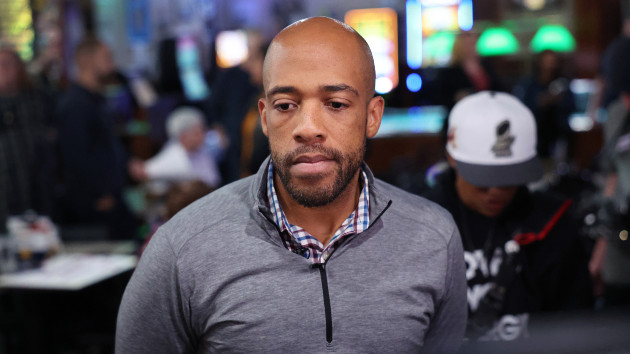After Hurricane Ian now is the time to review your insurance coverage
Written by ABC Audio All Rights Reserved on October 16, 2022


George Bokios faced a quandary in the first week after Hurricane Ian hit Southwest Florida.
Grateful for the safety of his family, and understanding of the first responders whose rightful focus was assisting survivors, the Sanibel Island property owner nonetheless was anxious to see what Ian had made of the two first-floor condos he has owned for decades. He didn’t know whether to reach out to his insurance provider or wait.
“Rightfully so, they’re emphasizing taking care of any survivors or helping people, which should be the highest priority,” Bokios said in early October. “But as the property owner, it’s going to be a logistical problem getting everything done correctly.”
More:The property insurance market was melting down. Then Hurricane Ian flooded Southwest Florida
More:Citizens Property Insurance hits 1 million policies as rates set to increase starting in fall
More:Insurance crisis: Analysts cast doubt on Florida plan to replace Demotech as troubled insurers grow
And many Southwest and Central Florida dwellers have found that problem way more complex than they could ever have imagined.
In some cases, property owners are finding that while they were covered by insurance for damage from a storm’s powerful winds, they weren’t financially protected against damage caused by flood waters from Ian’s record-setting storm surge.
Others are finding that insurance deductibles require them to first dole out out-of-pocket costs that far exceed their savings or rainy day funds. And some are finding out that their homes were covered, but not their screened-in patios.
So what is a homeowner, condo owner or renter to do now that Ian has passed, or before the next storm hits?
Insurance experts say now is the time to learn from the harsh lessons that Hurricane Ian has taught on Florida’s Gulf Coast.
After the storm: Surveying damage, hiring adjusters and contractors
For example, in Bokios’ case, homeowners should understand that they cannot file a claim without knowing the extent of property damage. But that is why having photos of all your belongings and home interior will be critical once you survey that damage, industry professionals have long advised.
“Every claim is different. Every home is different. Every storm is different,” said Edwin Leal, president-elect of the Florida Association of Professional Insurance Adjusters. “Although you can probably assume that there is damage, I would caution with reporting blindly.”
Insurance analysts recommend that if the homeowner or a neighbor or a professional like an adjuster isn’t able to reach the property to verify the damage, use common sense.
In the case of barrier islands like Sanibel, where high storm surge was widely reported, Leal said it’s good to “get yourself on the radar” with their insurer. Those further inland might want to wait and verify, he added, to have specific information to give to the company.
“I’m hearing stories about adjusters having to rent a boat or find someone who can take them onto the island to do the inspection,” said Leal, who also runs Tampa-based Claims Assist Florida. “That’s a challenge.”
Friedlander suggested going straight to the insurance company if a homeowner is unable to reach their property and explain their situation.
“Insurers today are using more drone technology and other technological solutions,” Friedlander said. “That is up to the insurance company how they’re going to assess the loss.”
When going through the claims process, whether it’s hiring a public insurance adjuster or a contractor, homeowners should be careful who they choose. Often, contractors comb through neighborhoods after a storm and offer to fix damage, even if it’s not there.
“Policyholders ought to be very, very, very careful before signing anything that gives away all or a portion of their claims,” said Michael Higer, attorney at Miami-based Berger Singerman.
For resources to make sure you’re dealing with a licensed professional, property owners can visit BeClaimSmart.com or visit the state Department of Financial Services website at MyFloridaCFO.com.
After the storm passes: What’s in my policy, anyway?
Homeowners should use the time now to find out from what perils their property is covered by reviewing the declarations page, which can be found at the front of the policy, said Mark Friedlander, spokesperson for the Insurance Information Institute. This typically includes a summary, limitations, deductibles and how the claims process functions.
A homeowner can also reach out to their insurance agent to discuss the policies they have. Insurance industry experts suggest homeowners do this at least once a year, whether that’s before hurricane season, after their policy is renewed or now, after a major storm has passed.
Most windstorm damages are typically covered in homeowners insurance policies. For example, if strong winds blow off a property’s roof and rain causes water damage, that would likely be covered by windstorm coverage. For renters, it’s up to the property owner to have windstorm protection for the exterior of the property and interior appliances and fixtures, like cabinets, while the renter insures their possessions inside the unit.
But flood insurance, which covers water damage from the ground such as storm surge, is not included in a standard homeowners’, condo owners’ or renters’ insurance policy. It’s a policy that must be sought separately, either by the National Flood Insurance Program (NFIP) or the private market. Private insurance companies sometimes offer flood coverage through the “Write Your Own” program.
Should you get flood insurance? Things to consider
Flood insurance is required for homeowners with mortgages living in FEMA-designated high-risk flood zones. But 40% of federal flood insurance claims are from outside of high-risk zones, according to the program. About 18% of homeowners in Florida have flood insurance, compared to 4% nationwide.
“We’ve seen this play out many times. You don’t have to be near the area where the storm struck to have catastrophic damage,” Friedlander said of flood damage.
On average, a federal flood policy costs $985, Friedlander said. Flood insurance policies with the federal program take 30 days to go into effect, but private insurers have policies that kick in faster.
Regardless, an industry spokesman counsels property owners to seek flood coverage.
“To us, there’s no situation where you should not strongly consider flood insurance,” Friedlander said. “It could flood anywhere and be catastrophic. You can’t predict that. You need to be financially prepared. That’s what insurance is for.”
Others cautioned consumers should calculate the cost-benefit to carrying a flood policy, meaning understand precisely what additional coverage and financial reimbursement would be provided.
Insurance attorney Higer was hesitant to recommend every homeowner get flood insurance.
“That’s kind of like saying, ‘Do you want some fancy doohickey that you may or may not be able to take advantage of and an expense that you want to incur?’ It probably provides you a nominal benefit,” he said.
Even if someone does have flood insurance and needs to use it, Higer said the insurance might offer “some benefit, but it comes at a reasonably significant expense.”
Your house is covered, but what about your car?
Another thing to consider reviewing is how insured your car is against storm damage. Comprehensive coverage is not required in Florida, but it’s what will protect you from non-crash issues like storm damage — such as the interior of the car flooding from rising street waters or a tree falling on the vehicle — as well as theft and fire, Friedlander said. This type of coverage is often required when leasing or financing a car.
About one in eight Florida homeowners do not have any insurance at all, whereas one in 20 U.S. homeowners who do not, according to data from the Insurance Information Institute. That’s because homeowners without mortgages, as a result of buying a home in cash or finally paying off the loan, aren’t required to have insurance.
“A lot of people paid off their mortgage and decided coverage was too expensive. Some families are in a good financial position to do that. Many are not,” Friedlander said.
I wasn’t affected by Hurricane Ian. What should I do?
The recommended advice is to review your policy at least once a year, whether that is before hurricane season or at the time of renewal.
But now is the next best time to review your policy, experts said.
“We’re not through hurricane season,” Friedlander said, noting that Superstorm Sandy and Hurricanes Michael and Wilma struck in October. “Don’t wait until next year.”
Leal suggested that homeowners pose specific hypothetical scenarios to their insurance agents to fully understand what their policy covers, and more importantly, what it doesn’t.
Questions such as:
- Does the policy cover a pool enclosure crumpled by high winds?
- What about fences, sheds or other exterior features not attached to the home?
- How, if at all, has the policy changed after renewal?
- How long after the claim is accepted will payment be given?
- How does the company handle claims?
And so on, to avoid any surprises after disaster strikes. Asking these questions may lead a homeowner to find they’re sufficiently covered, or they might need to purchase add-ons or “endorsements” to their policy. Things like living expenses can be added onto flood insurance policy, or perhaps coverage of a pool enclosure can be added to your wind policy.
Homeowners should also maintain a digital inventory of pre-storm photos and videos of the property’s exterior and interior. That way, there is proof of what was lost and the condition of the home, in case the homeowner needs to push back claims that the damage is wear-and-tear, which is not covered by this insurance.
What about this hurricane deductible?
Leal also noted that homeowners should know how much their general deductible is, as well as that of their hurricane-specific deductible.
This hurricane deductible is imposed on storm-related damage that occurs in between the time a hurricane watch or warning is issued for any part of Florida by the National Hurricane Center and 72 hours after the last Florida hurricane watch or warning is lifted.
When non-hurricane bad weather causes damage, a homeowner must generally meet their deductible, often a fixed figure or percentage of the home’s insured value, before the insurance provider will start to pay for repairs.
But for damage caused by a hurricane there is a separate deductible homeowners must meet, often higher than the more general, so-called “all peril” deductible. These hurricane deductibles can be 2%, 5% or 10% of the insured value, which can come as a shock to many homeowners, Leal said.
“The reaction I always get is, “No, no. That’s a mistake. There’s no way.’ And it’s sad because there’s really nothing you’re able to do at that point. I can’t really help them,” he said.
For example, a homeowner’s all peril deductible could be $2,500 while the hurricane deductible may be 5% of a home’s value — which at $300,000 of insured value would place the deductible at $15,000.
Even if the cost to repair damage is less than the deductible, the state Department of Financial Services said to still file a claim. That way, the company has a record of a credit that can be applied to the hurricane deductible if another storm hits.
“We have to reflect on this situation and we’ve got to learn from it,” Leal said.
Hannah Morse covers consumer issues for The Palm Beach Post. Drop a line at hmorse@pbpost.com, call 561-820-4833 or follow her on Twitter @mannahhorse.
The post After Hurricane Ian now is the time to review your insurance coverage appeared first on Correct Success.







